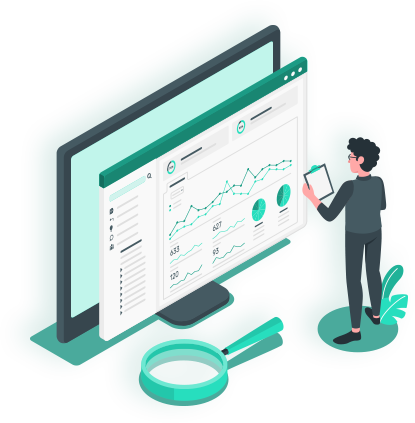The digital marketing industry is becoming more and more competitive. Targeting digital marketing KPIs and tracking the evolution of your business performance is an important step in the future of your business.
Often time, evaluating and keeping track of your results is turning to be one of the most important steps in the process of running a business. Not setting KPIs is like driving with your eyes closed. So, here's what you should know about this topic:
- What Is a Digital Marketing KPI?
- Top 23 Digital Marketing KPIs Any Marketer Should Track
- What NOT to Track
- How Do You Measure Digital Marketing Performance?
- Tools to Track KPIs for Digital Marketing
There are some things we need to consider; we can’t go blindfolded, without knowing where your business is heading. Deciding which KPIs are effective and relevant to your company and the way you set them up will help you get the performance you’re aiming for.
What Is a Digital Marketing KPI?
Analytics data, financial and indicators, SMART goals are compressed in the complex term of digital marketing key performance indicators (KPIs).
Put it simply, the digital marketing KPIs are the goals we set to measure the progress of your business in a time-frame. You get to find your starting point and then track the performance of your business through the KPIs before they are actually due.
It is highly important to establish the time and set quantifiable KPIs to be aware of what you need to achieve and how much time you have left.
Top 23 Digital Marketing KPIs Any Marketer Should Track
Lots of marketers rely on marketing KPIs to make business decisions and assess the evolution of the company. To have a complete overview of the KPIs you should follow, it would be highly beneficial to keep all the information in one place.
Let’s dig in and talk about the most important digital marketing KPIs:
1. Social Engagement Rate
It shows you how many people who see your social posts interact with your page by liking, commenting, sharing your content. Most of the social platforms offer this metric, so you don’t have to scoop too much to find it. It is helpful to know the engagement rate because it will help you find out what type of social content your audience likes, so you keep feeding them valuable information.
According to Aamplify, the engagement rate can be calculated through a simple formula:
Sum likes, comments and shares, divide them to the total number of fans and multiply the result by 100 to get the percentage number.
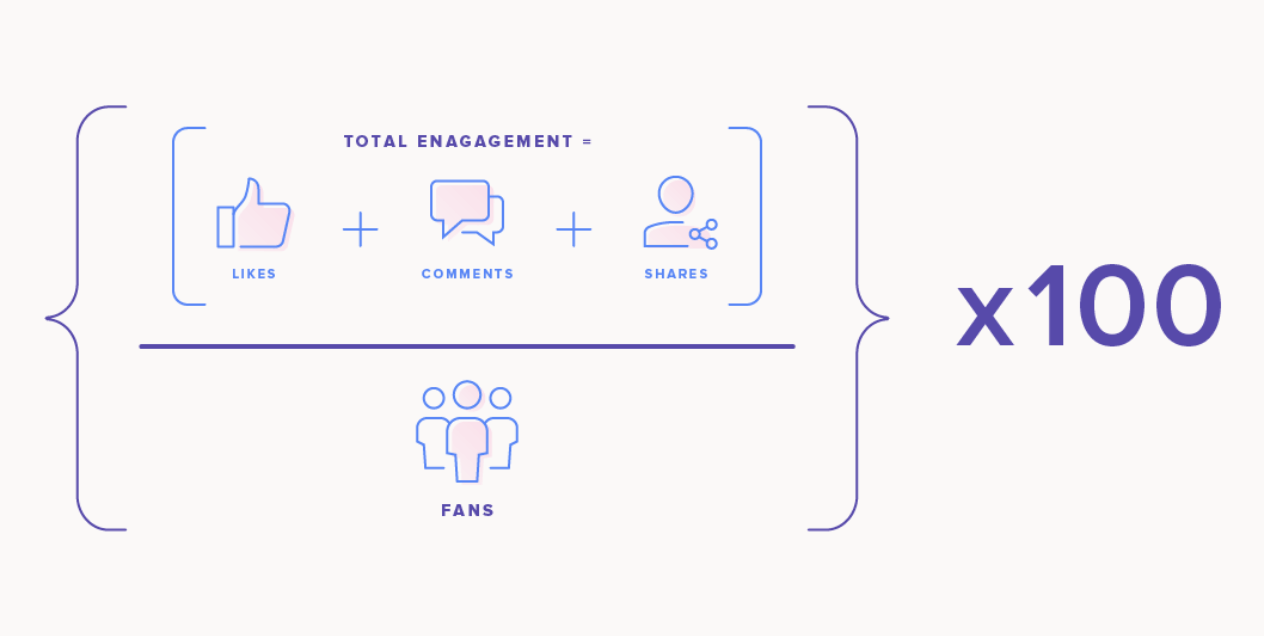
2. Social Media Traffic
It is the volume of people that come to your website from social channels (social network - referral traffic). You can track this metric to find out which social platform is more efficient and find out whether it’s related to a specific period or a particular social media campaign you’re promoting.
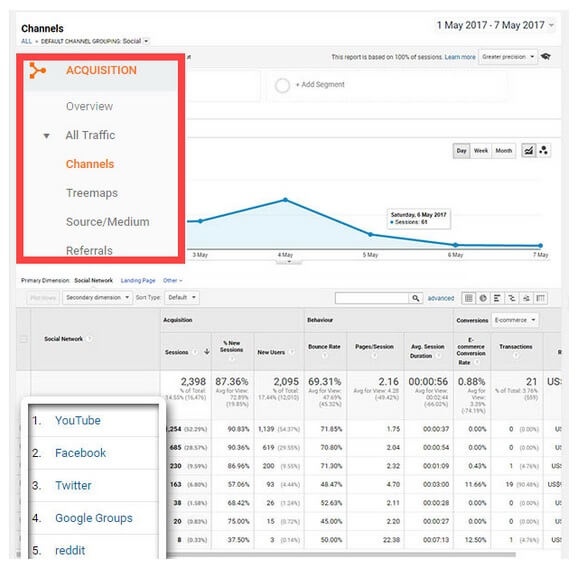
3. Social Media ROI
Measuring the return on investment on social media can be overwhelming. We understand that. If your brand depends on social media strategy (such as brand awareness, revenue, customer satisfaction, and similar) you need to find out how much revenue you get after all the resources, time, and money you’ve invested. The formula is simple, but gathering all the information will require more in-depth research:
Revenue / investment (ad budget, people hours, salary, etc.) X 100 = social media ROI (%)
4. Web vs. Social Mentions
They are two brand monitoring metrics. When people say something about your brand on any platform or site without a direct tag or link, you get a mention. That, my friend, is valuable because those are honest opinions, insights, information you could use for future brand strategies.
5. Linked vs. Unlinked Mentions
Finding out how many linked and unlinked mentions you have will help you understand how well the audience knows your brand. Plus, you can build a campaign for contacting people and bringing brand awareness.
6. Sentiment Analysis
It is a complex KPI that classifies emotions (positive, negative, and neutral) for each brand mentions. For example, you can find out if the audience had a positive or negative experience regarding your brand and it will help you manage your brand reputation.
7. Top Influencers
They are experts that mention your brand. You can find out what type of influencers talk about your brand, what they say, and many more insights. It is highly beneficial for a brand to be mentioned (for free!! nonetheless) by influencers because those mentions are honest, unbiased, and the message is received by a big audience. There are tools that can help you find out Top influencers, such as BrandMentions.
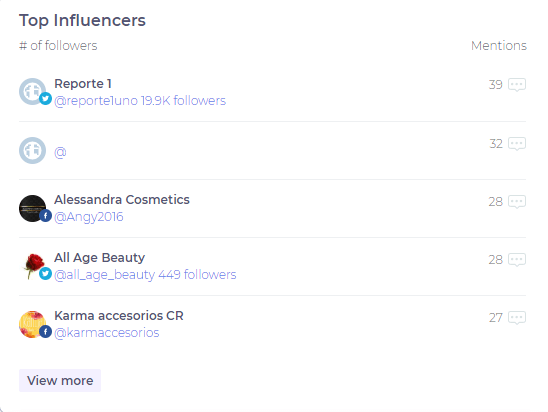
8. Returning vs. New Visitors (Loyalty Rate)
They are KPIs on website traffic. The loyalty rate can give you information regarding how relevant the information on your site is for your audience. If they like what they see, they’ll return, and you should keep them engaged because returning visitors often have lower bounce rates, higher avg. session duration and pages per session. That means more quality traffic. A returning visitor is sometimes better that 5 new visitors. You can use a free WordPress plugin to watch visitor recording of returning visitors.
9. Bounce Rate
It represents the percentage of visitors that enter your site and then leave rather than continue to visit other pages. If you have a high bounce rate that means they don’t find what they are looking for. It might be a problem regarding what they are searching for and what you are offering. Check your content and evaluate your website for technical issues as well.
10. Product Performance
It shows you which products are most effective. In Google Analytics you can easily find them. Go to Conversions » Ecommerce » Product Performance and here you have it.
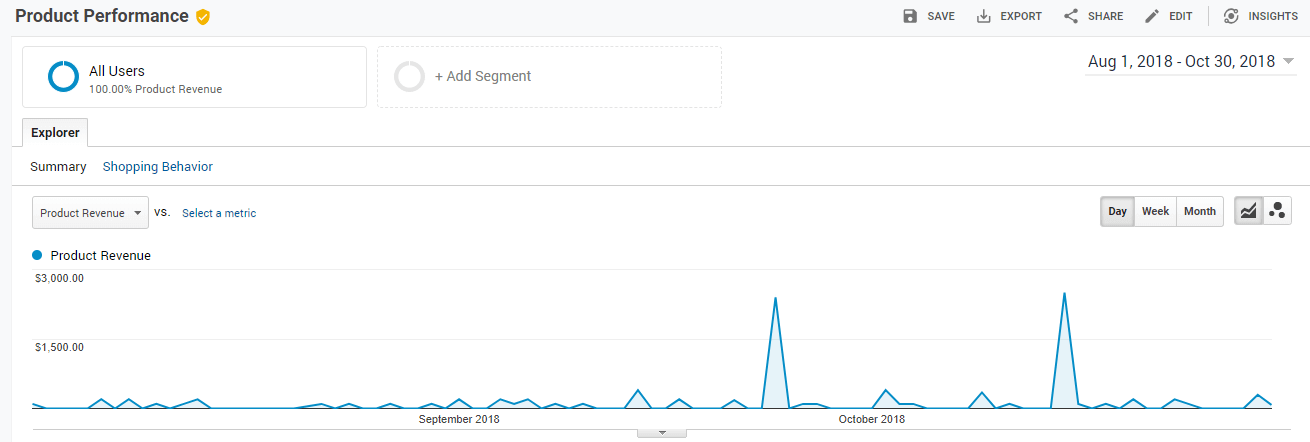
11. Click-Through Rate
CTR shows the percentage of people that view your page, email, or advertisement and click on the link to enter your site. On Google Search Console you can see the CTR for people that search on Google and then click on the search results to get on your site.
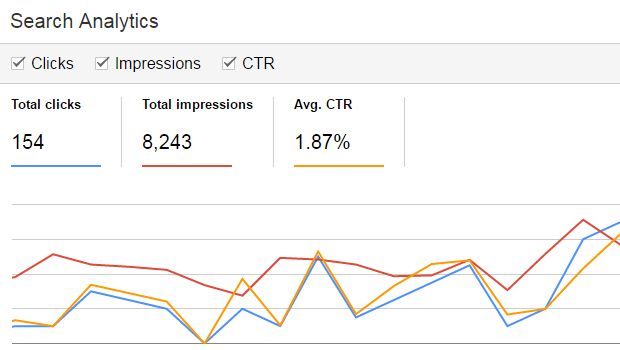
12. Customer Lifetime Value
CLV is the total worth to a business of a customer over the whole period of their relationship. For any growing company that is an important KPI that will determine the performance of the business. You can make predictions and see how much you’ll spend in the future for keeping those customers.
13. Monthly New Leads
It is the number of prospects collected by the business on a monthly basis. It is important to generate quality leads because at least one of them will become a paying customer. The process of acquiring leads means time and money, so they should be valuable.
Qualified leads per month is a prospect created by the marketing department and “accepted” by the sales team.
15. Conversion Rate
It is another social media KPI you should be following. A conversion rate is the percentage of consumers who take the action you want them to take. To find out your monthly social conversion rate, you need to check your goals in analytics. For example, one goal could be the number of subscribers on site, and you’ll have to divide the total of subscribers to the total number of visitors on the blog, to see the conversion rate for that goal. You can track multiple conversations rates.
16. Cost per Lead
CPL is a pricing model used in an ad campaign, for example, where the advertiser pays for a specific action made by the visitor (sign up form, call, etc.) to convert them into a lead.
17. Cost per Conversion
CPC is paid search KPI and it shows you how much it costs to obtain a customer. Depending on the goal set on your ad campaign, a conversion could be a purchase made, signing up for something, or watching a video, make a contact call and so on.
18. Cost per Acquisition (CPA)
You can use it to measure the aggregate cost to acquire one paying customer on a campaign or channel level.
19. Inbound Links and Referring Domains
They are two SEO KPIs that show you how strong your website is and how many domains are pointing to your site. For a natural link profile, a website should have an appropriate number of links compared to the referring domains, otherwise it will look artificial.
For example, if you have 2 mil links from 320 referring domains that means the link-building scheme was manufactured, and that’s not natural. It is shady.
20. Search Visibility
It is a metric that shows the overall rankings of your whole website. The metric is calculated by taking into consideration all your ranking keywords and the evolution of that score, shows if your ranking improved or decreased based on something you didn’t do, on a Google update, on a bad technical SEO functionality, website design or something else in particular.
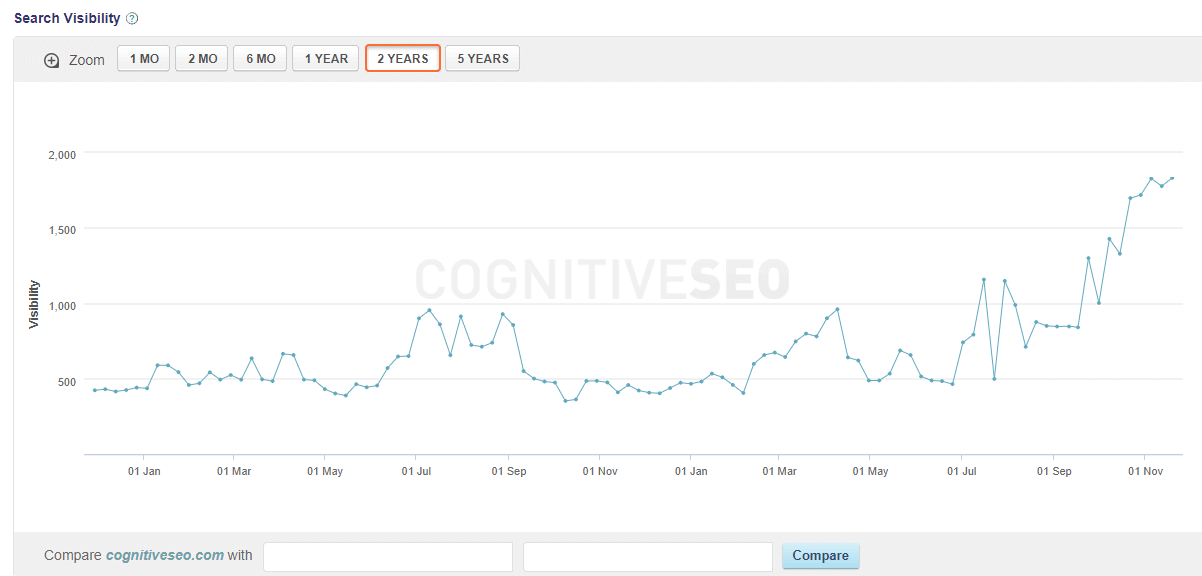
21. Natural Links vs. Unnatural Links
By comparing natural vs. unnatural links you can see if your website is at potential risk of being penalized by Google. If you have a high number of unnatural links you will be penalized in case you haven’t been already. A natural proportion would be to have at least 30% unnatural links, although that is a high percentage.
22. Organic Traffic
It is represented by those visitors that enter your website naturally from performing searches on search engines. This is the most desired type of traffic any business would want because that means you have high ranking pages and people liked what they found on the search results when they saw your post. When they enter your website, that’s another story. The other metrics you’ve discussed on website traffic should be tracked from this point. Keep them hooked.
23. Top Ranking Keywords
If you have a high number of ranking keywords, that means you have a strong and authoritative website. Use tools to track all the important targeted keywords and develop your digital marketing agency based on those findings.
Of course, there are some other metrics you'd need to measure, yet, there are the most important ones. You need to know that generally, digital marketing KPIs fall in one of these main categories:
- Social Media: engagement rate, traffic from social media, conversion rate, Social Media Return on Investment (ROI).
- Brand Monitoring: number of mentions (web vs. social mentions), linked vs. unlinked mentions, positive vs. negative sentiment analysis, top influencers & top websites mentions.
- Website traffic: organic traffic, returning site visitors vs. new visitors, average time on a page, bounce rate, traffic type for your pages, product performance, click-through rate (CTR), e-commerce overview to keep track of the Average Order Value (AOV), customer lifetime value (CLV).
- Lead generation: monthly new leads/prospects, qualified leads per month, cost per lead, customer retention rate.
- Paid advertising: conversion rate, cost per conversion, cost per acquisition, CTR on PPC campaigns.
- Content marketing & SEO optimization: inbound links and referring domains to a website, search visibility, natural links vs. unnatural links, dofollow vs. nofollow links pointing to a domain, volume of keywords ranking in top positions.
What NOT to Track
The KPIs that you shouldn’t track are those that don’t matter, called vanity metrics. These metrics don’t bring value to any marketer’s strategy (talking of which, here are some cool ecommerce marketing strategies to check out for 2025). It doesn’t help your business to grow or achieve the goals you’ve set. You can keep track of them if you want to, but they are not important.
It is important to stick to action-based metrics, long-term marketing metrics, and KPIs, otherwise, you’re wasting your time. And in this case, time is money, so you’ll lose money, too.
Vanity metrics carry some sort of value, but they don’t give you some much stand-alone information. You can use it and create connections with other metrics if you’d like.
Here are some marketing metrics and KIPs you should not track religiously, but rather keep an eye on, just to be aware:
- Pageviews
- Visits
- Page authority
- Google Page Rank: even though Google uses this metric in their algorithms, for webmasters and marketers it has become a vanity metric; it’s just a number basically.
Looking at some numbers won’t give you any hints of what you need to do to increase or decrease them, depending on the case.
How Do You Measure Digital Marketing Performance?
You should measure your digital marketing performance by tracking goals that are important to your business and mean something, not just some numbers that don’t tell you anything, which are vague and not connected with the business’s goals. Here you can check out some interesting eCommerce KPIs that can be useful.
Don’t scratch the surface with some numbers and then wonder why your business isn’t working.
Look in-depth for more meaningful data, make connections between the metrics, and see how they interact, don’t just look at the surface-level web analytics data.
Plan, design, use tools to track performance, test, analyze the results, draw conclusions and restart the process. If you’re starting something new, try A/B testing, trial and error.
Tools to Track KPIs for Digital Marketing
There is a tool for everything. It is important to make smart decisions and be careful when we choose a marketing tool. Trial first, and see what data you can pull and if it’s reporting well, then decide.
Here’s what you could use to track the KPIs mentioned above and many others related:
- Sprout Social is a social media management software that can be best used for side-by-side comparisons of social media channels vs. competitors.
- Hootsuite is a social media management tool for all your social media channels in one place, allowing you to manage them more efficiently and get all the insights you'll need for future improvement.
- BrandMentions is a social listening and brand monitoring tool where you could track mentions, hashtags, sentiment analysis, top influencers, and compare your results with your competitions.
- StatCounter is a web analytics tool that helps you track, analyse and understand your visitors.
- Google Analytics is a web analytics tool where you can track all the information about traffic and goals for your website.
- HubSpot has a lot of integrated software tools, such as CRM platform and form builder which are professional lead generation tools.
- Pardot is a well-known lead generation tool that helps you manage and qualify sales leads.
- SpyFu is a PPC tool that shows all the places your competitors’ ads were displayed and finds the most profitable keywords from them based on their advertising history.
- KeywordSpy is a PPC keyword research tool that shows your competitors' most profitable ads and keywords.
- cognitiveSEO is an all-in-one SEO tool that can help you analyze your profile link, keyword ranking, spot any unnatural patterns, find linking opportunities, fix technical issues, and make your website perform better and faster.
- Google Search Console is a service where webmasters can check indexing status and optimize visibility of their websites.
You need to see what’s good for your business. In the process of planning, tracking, and evaluating the results for your digital marketing KPIs, you’ll have to perform tests and find out what metrics you need to track and what metrics you should not.
Focus on the KPIs that drive actions and results, lead towards the goals you’ve set, help you transform your business. You’ll have error and trial on the way because only by testing you’ll see exactly what's fit for you. Use lead generation tools and digital marketing apps to help you out.
Seek for new technologies and tools and get inspiration from experts to see guidance.

